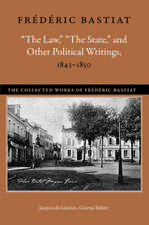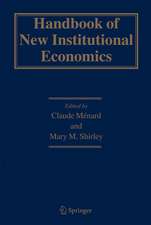The Elements of a Nonlinear Theory of Economic Dynamics: Lecture Notes in Economics and Mathematical Systems, cartea 343
Autor Carl Chiarellaen Limba Engleză Paperback – 22 mai 1990
Din seria Lecture Notes in Economics and Mathematical Systems
-
 Preț: 360.02 lei
Preț: 360.02 lei -
 Preț: 383.93 lei
Preț: 383.93 lei - 15%
 Preț: 693.39 lei
Preț: 693.39 lei -
 Preț: 384.09 lei
Preț: 384.09 lei -
 Preț: 380.07 lei
Preț: 380.07 lei -
 Preț: 446.26 lei
Preț: 446.26 lei -
 Preț: 497.37 lei
Preț: 497.37 lei -
 Preț: 380.84 lei
Preț: 380.84 lei -
 Preț: 384.86 lei
Preț: 384.86 lei -
 Preț: 378.34 lei
Preț: 378.34 lei -
 Preț: 399.67 lei
Preț: 399.67 lei - 20%
 Preț: 360.93 lei
Preț: 360.93 lei - 15%
 Preț: 643.16 lei
Preț: 643.16 lei -
 Preț: 379.09 lei
Preț: 379.09 lei -
 Preț: 404.76 lei
Preț: 404.76 lei -
 Preț: 385.62 lei
Preț: 385.62 lei - 15%
 Preț: 644.49 lei
Preț: 644.49 lei -
 Preț: 379.09 lei
Preț: 379.09 lei -
 Preț: 345.50 lei
Preț: 345.50 lei -
 Preț: 425.80 lei
Preț: 425.80 lei -
 Preț: 378.34 lei
Preț: 378.34 lei - 18%
 Preț: 775.65 lei
Preț: 775.65 lei -
 Preț: 392.60 lei
Preț: 392.60 lei -
 Preț: 401.61 lei
Preț: 401.61 lei - 15%
 Preț: 646.43 lei
Preț: 646.43 lei -
 Preț: 382.18 lei
Preț: 382.18 lei -
 Preț: 378.34 lei
Preț: 378.34 lei - 15%
 Preț: 637.59 lei
Preț: 637.59 lei - 15%
 Preț: 647.27 lei
Preț: 647.27 lei -
 Preț: 377.73 lei
Preț: 377.73 lei -
 Preț: 447.84 lei
Preț: 447.84 lei - 15%
 Preț: 644.49 lei
Preț: 644.49 lei -
 Preț: 386.00 lei
Preț: 386.00 lei - 15%
 Preț: 654.43 lei
Preț: 654.43 lei -
 Preț: 415.02 lei
Preț: 415.02 lei -
 Preț: 411.54 lei
Preț: 411.54 lei -
 Preț: 398.92 lei
Preț: 398.92 lei -
 Preț: 398.92 lei
Preț: 398.92 lei -
 Preț: 392.75 lei
Preț: 392.75 lei - 15%
 Preț: 635.47 lei
Preț: 635.47 lei - 20%
 Preț: 653.56 lei
Preț: 653.56 lei -
 Preț: 379.86 lei
Preț: 379.86 lei -
 Preț: 495.46 lei
Preț: 495.46 lei -
 Preț: 447.99 lei
Preț: 447.99 lei -
 Preț: 378.71 lei
Preț: 378.71 lei - 15%
 Preț: 637.13 lei
Preț: 637.13 lei -
 Preț: 385.84 lei
Preț: 385.84 lei -
 Preț: 378.54 lei
Preț: 378.54 lei - 15%
 Preț: 666.55 lei
Preț: 666.55 lei
Preț: 382.18 lei
Nou
Puncte Express: 573
Preț estimativ în valută:
73.15€ • 79.49$ • 61.49£
73.15€ • 79.49$ • 61.49£
Carte tipărită la comandă
Livrare economică 21 aprilie-05 mai
Preluare comenzi: 021 569.72.76
Specificații
ISBN-13: 9783540526223
ISBN-10: 3540526226
Pagini: 168
Ilustrații: IX, 149 p.
Dimensiuni: 170 x 244 x 9 mm
Greutate: 0.28 kg
Ediția:Softcover reprint of the original 1st ed. 1990
Editura: Springer Berlin, Heidelberg
Colecția Springer
Seria Lecture Notes in Economics and Mathematical Systems
Locul publicării:Berlin, Heidelberg, Germany
ISBN-10: 3540526226
Pagini: 168
Ilustrații: IX, 149 p.
Dimensiuni: 170 x 244 x 9 mm
Greutate: 0.28 kg
Ediția:Softcover reprint of the original 1st ed. 1990
Editura: Springer Berlin, Heidelberg
Colecția Springer
Seria Lecture Notes in Economics and Mathematical Systems
Locul publicării:Berlin, Heidelberg, Germany
Public țintă
ResearchCuprins
1. The Need for a Nonlinear Theory of Economic Dynamics.- 1.1 Introduction.- 1.2 Early Nonlinear Theories.- 1.3 Development of the Theory of Dynamical Systems.- 1.4 Problems in the Current State of Economic Dynamics.- 2. The Theory of Dynamical Systems.- 2.1 Introduction.- 2.2 Existence and Uniqueness Results.- 2.3 The Linear System x — Ax.- 2.4 Nonlinear Systems on the Plane.- 2.5 Analysis of Limit Cycles.- 2.6 Relaxation Oscillations.- 2.7 Higher Dimensional Nonlinear Systems.- Appendix 2.1.- 3. A New Look at Some old Endogenous Cycle Theories.- 3.1 Introduction.- 3.2 A General Model of Multiplier- Accelerator Interactions.- 3.3 Goodwin’s Nonlinear Accelerator Model.- 3.4 A Saturation Type Nonlinear Accelerator.- Appendix 3.1.- Appendix 3.2.- 4. Analysis of the Effects of Time Lags and Nonlinearities in Macroeconomic Models Incorporating the Government Budget Restraint.- 4.1 Introduction.- 4.2 Specification of the Model.- 4.3 Dynamic Behaviour of the Model.- Appendix 4.1.- Appendix 4.2.- 5. Limit Cycles in Higher Dimensions — the Effect of Time Lags on Goodwin’s Model of Cyclical Growth.- 5.1 Introduction.- 5.2 The Goodwin Model with a Time-Lag.- 5.3 Local Stability Analysis.- 5.4 Approximation of the Limit Cycle.- 5.5 Discussion.- Appendix 5.1.- Appendix 5.2.- Appendix 5.3.- Appendix 5.4.- Appendix 5.5.- Appendix 5.6.- Appendix 5.7.- 6. The Cobweb Model: Its Instability and the Onset of Chaos.- 6.1 Introduction.- 6.2 The Nonlinear Cobweb Model.- 6.3 Discrete Time Dynamics.- 6.4 Period Doubling to Chaos.- 6.5 Onset of Chaos in the Cobweb Model.- 6.6 Discussion.- 7. Perfect Foresight Models and the Dynamic Instability Problem From a Higher Viewpoint.- 7.1 Introduction.- 7.2 The Basic Nonlinear Model of Monetary Dynamics.- 7.3 The Naive Dynamics of the PerfectForesight Case; ? = 0.- 7.4 The Dynamics of the Adaptive Expectations Case; ? > 0.- 7.5 Adaptive Expectations as ??0+.- 7.6 The Discrete Time Model of Monetary Dynamics.- 7.7 Discussion.- Appendix 7.1.- Appendix 7.2.- Appendix 7.3.- Appendix 7.4.- Appendix 7.5.- Appendix 7.6.- 8. Conclusions and Further Developments.- References.


















